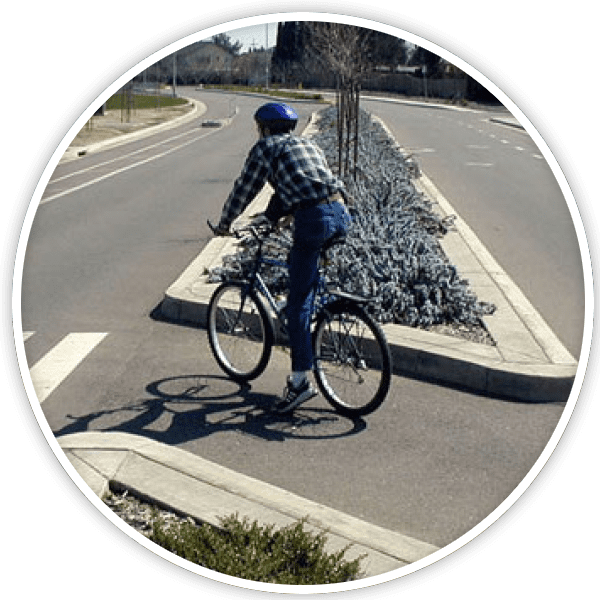If space allows, mid-block crossing designs can utilize an angled pedestrian refuge to increase safety and awareness.
 When angled towards oncoming traffic, as shown in the below illustration, trail users and vehicle operators to make eye-contact with one another before the crossing occurs. Angled crossings can increase awareness and safety over other pedestrian refuges, and are preferred in higher volume collector streets.
When angled towards oncoming traffic, as shown in the below illustration, trail users and vehicle operators to make eye-contact with one another before the crossing occurs. Angled crossings can increase awareness and safety over other pedestrian refuges, and are preferred in higher volume collector streets.
- Greenways should cross streets at a 90 degree angle. The angled pedestrian refuge should be at minimum 45 degree angle to the adjacent streets.
- Vehicular scale greenway signage should be incorporated adjacent to the crossing to alert motorists the greenway is crossing the street. All signage shall conform to MUTCD standards.
- Regulatory warning and stop signs shall be used for the greenway requiring users to stop before proceeding through the crossing.
- Where the trail and sidewalks intersect, concrete surface shall be applied.
- To promote traffic calming, the preferred lane width for streets shall be 11’-0” in areas adjacent to median refuge. Lane widths to comply with local standards.
- Crossings should be designed to provide high visibility. High visibility lane markings and signage should be used to call attention to the crossing, conforming to MUTCD standards.
- For the greenway route, all crossings and sidewalk within the pedestrian refuge shall be the same width as the trail.
- All crossings shall comply with ADA and/or PROWAG guidelines The use or configuration of Detectable Warnings and other ADA components may be phased out or significantly changed. ADA components shall comply with the latest ADA and/or PROWAG guidelines and local standards.
- Opportunities to incorporate stormwater management elements and pervious surfaces should be considered to establish the greenway corridor as a sustainable amenity for the communities it serves.
- Existing right-of-way (ROW) widths and locations shall be determined by designers prior to the performance of significant design work. All proposed improvements are to remain within existing ROW whenever possible. Adjustment to roadway widths, parking extents, and other changes to the geometry of trail and intersection components are preferable to ROW acquisition.
- While final design will be based upon specific intersection geometry, elements in the recommended layout should be considered as basis of design.
Plan Diagram

COMPONENTS: Click below for more information on each component.
1) Trail
2) Crosswalk